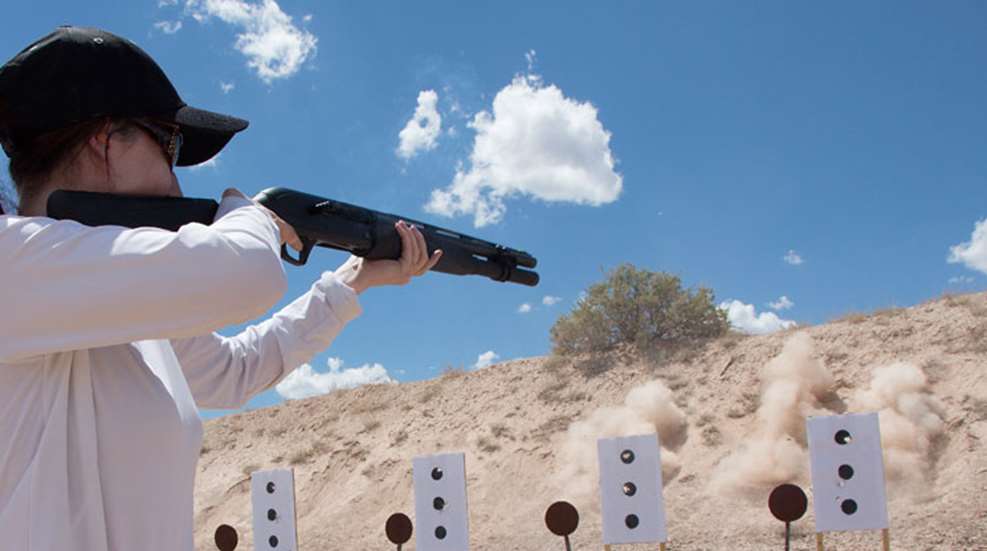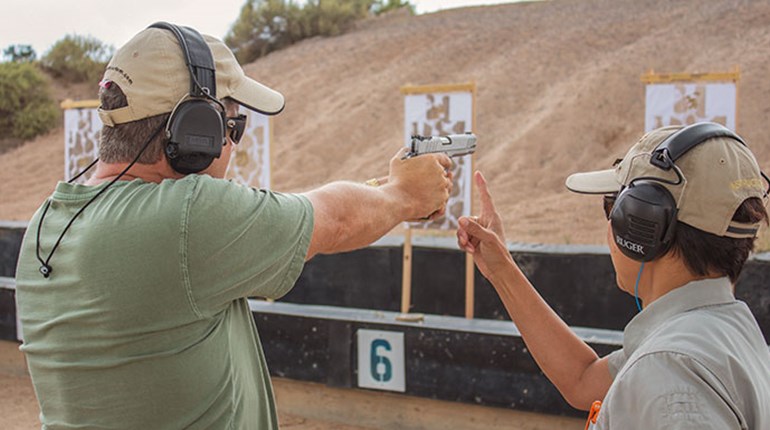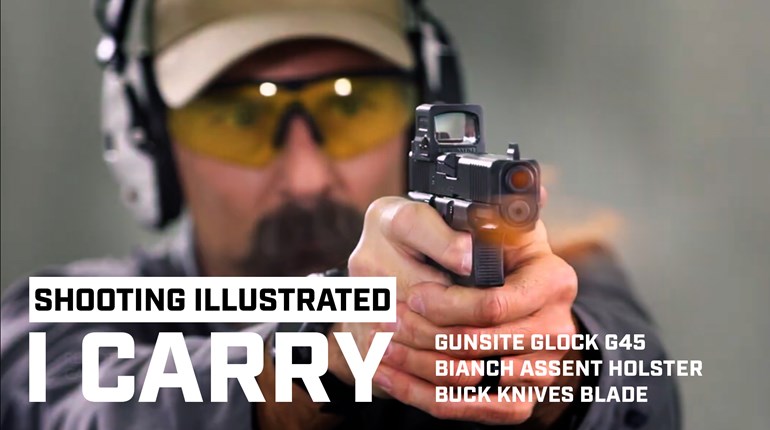
Shotguns are immensely popular for home defense, and for good reason. It’s not that rifles and handguns won’t work well for home defense, it’s just that shotguns have so much going for them in that realm.
With the array of ammunition available, shotguns can shoot everything from “less-lethal” loads (think rubber bullets, bean bags and others) to snake shot, to buckshot (.30+ caliber projectiles!) to 400-plus grain slugs. While most of us who aren't in law enforcement or the military will negotiate shorter distances with our defensive shotguns, the scattergun's versatility does offer the ability to shoot ammo that can address targets at much longer ranges. On the flipside, there is shotgun ammunition that will travel and/or penetrate less, and that might be appropriate for your circumstance. When we add to this the array of accessories also available for them (which isn't always necessarily a good thing; we'll touch more on this later), shotguns might be the most versatile home defense firearms you can get.
So, how do you set up a home-defense shotgun?
If you’ve decided on a shotgun for home defense, identifying your conditions is your next step. These will be your guidelines as you select a specific shotgun and any accessories and modifications. First, consider what “home” you’re defending. Do you live in an apartment building, with relatively tight quarters? Are you in a single-family dwelling in a suburban neighborhood? Perhaps you have acreage around you that you’d consider defensible territory. What’s the longest distance that you might have to shoot across? Are your adversaries likely to be two- or four-legged? (Note that many of these conditions also influence ammunition choices. Ammunition is a category all its own, and deserves more space than we have here. We’ll focus on the shotguns themselves.)
Next, consider your own firearms skill, physicality and willingness to train and practice. Focus on what I consider to be the two most important criteria for any defensive firearm: usability and reliability. Assuming the appropriate ammunition is in it, your shotgun’s usability and reliability are going to determine your ability to stop your threat. Note that usability is extremely subjective, and it is so for any defensive tool. Usability depends on the user, and what s/he can operate best.
When it comes to things you’re going to have to do or operate in defensive situations, remember that simplicity is key. Simplicity allows the defender to focus on doing what s/he needs to in order to solve a problem. With firearms in general and shotguns especially, simplicity goes hand-in-hand with usability, and usually with reliability too. Conversely, usually the more complicated and cluttered a shotgun, the less usable, reliable, and thus effective it is.
While the simple-is-better notion might seem obvious to you, shotguns have a weird way of encouraging the opposite. There are just so many accessories (gadgets!) on the market that it’s hard to hold back.
That said, I and other “professionals” preach restraint! It’s not that accessories are a bad thing, but if they don’t add to the usability, reliability and effectiveness of your shotgun, they shouldn’t be on it. In fact, if they don’t add to the usability, reliability and effectiveness of your shotgun, they’ll probably detract from these. I’ve talked to numerous defensive shotgun instructors—from police and military trainers to those who work with citizens—and there are definitely some shared opinions among us.
Which action should you choose?
Many opinions land squarely on the side of pump shotguns, mostly because of their reliability and robustness. They’re more forgiving of ammunition choices, less likely to hiccup, and even if that rare malfunction occurs, they are generally easier to “fix” (and still have a chance to fire in a timely fashion). Fans of semi-autos cite their firing speed, simplicity (no need to manually work the action to rechamber), balance and weight (usually lighter than their pump counterparts).
What accessories do you need?
For starters, consider installing better sights: Despite the fact that they're commonly called “scatterguns,” shotguns used in defensive situations should be aimed. This is true regardless of what ammunition you’re using, and becomes ever more important when dealing with targets that are active threats—all threats need to be stopped as efficiently as possible, and only well-placed shots will achieve this. Most shotguns start off life as sporting and recreational tools, and don’t come with appropriate or adequate sights.
Dedicated lights are the next choice of most instructors and users. “Trying to handle a [non-attached] flashlight and work a shotgun—regardless of action type—is just that much harder,” says Mike Moore, who is both a rangemaster and the gunsmith at Gunsite. “In most situations, you’ll want the option of turning the light on or off, and that can be a real challenge with a handheld light.”
AMDs, or “ammunition management devices,” are next on most lists. Attached ammo holders provide more advantage than mere extra rounds: A practiced shooter can quickly change the type of ammunition in his or her shotgun, and this is one of the most unique features of the system. Having a variety to select from may be important to your situation, and certainly having spare ammo on board is a plus. Note: Interestingly, while most experts advocate ammunition carrying devices for the shotgun, they also recommended only a one- or two-round extension to the magazine—not the three or even more that we often see on “tactical” shotguns. What gives? Says Tim Lehr, Director of Sales at Nighthawk Custom, the extra-length tubes make the shotguns heavy, and less balanced, and thus more awkward. Extended-mag tubes can also be a weak point. The more tube that's exposed, the more opportunity for it to be dented, possibly resulting in binding springs and followers, and feeding problems.
Lastly, slings were high on most lists. You’re going to need to use both hands at some point, and a sling allows you to keep the shotgun on your person, within your grasp at all times, and out of reach of unauthorized users.
The customization question
Both Nighthawk’s Lehr and Gunsite's Moore advocated making sure your shotgun operates smoothly, with no hitches or glitches. This may involve action work, dehorning, extractor work, and even upgrading some parts like springs, safeties and others.
Making sure your shotgun fits you is critical, especially with pump actions. Defensive pump action shotguns that are too long can cause users to “short-stroke”—working the action only part of the way necessary to completely eject and/or feed rounds. Similarly, semi-autos that are too long will result in an improper mount, which in itself can lead to malfunctions. Regardless of action type, a poor fit certainly compromises aim and recoil management.
What NOT to do….
Last but not least, there is strong agreement on the “don’t’s” for home-defense shotguns. Lehr says the biggest mistake he sees is, “People tend to want too much stuff on their guns!” Similarly, Moore says, “Trying to make shotguns into something they’re not” is a common problem he sees, both on the range and in his shop. “They are intended to be close-quarters weapons in home-defense, not rifles.” Lehr notes that adding accessories to cover every eventuality is not only impossible, but makes the shotgun heavier than it needs to be, and this can be a particular problem in the home, under close quarters: “Lighter shotguns are definitely better handling.” Moore adds that adding too many gadgets and too much weight can compromise reliability as well.
Focus! If a shotgun is your choice for home defense, congratulations! You’ve chosen a tool that offers unparalleled versatility. Choose your customizations carefully, and let your shotgun’s best features will shine through.






































